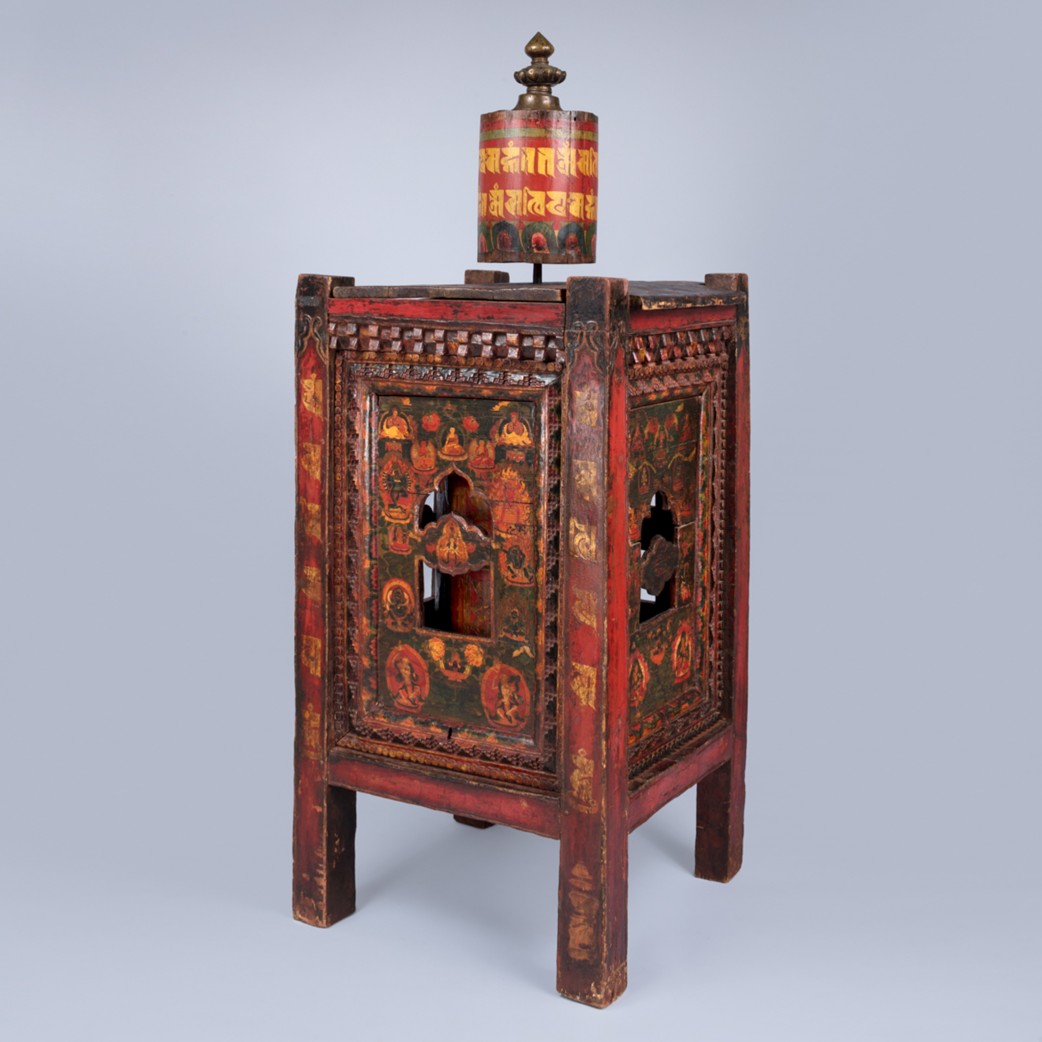
The exhibition The Power of Intention: Reinventing the (Prayer) Wheel (on view through October 14, 2019) explores how intentions shape our connections with the world. To have an intention is to have a desire to act, but not all intentions truly become actions. Without an intention, on the other hand, our actions become aimless. The gap between intention and reality raises a basic question of right and wrong. Is it more important to have good intentions, or to perform actions that have good results?
Buddhism affirms the overarching importance of good intentions. Synonymous with good karma, positive intentions have the power to lead to better future circumstances and the possibility of liberation.
Intention in Buddhist Philosophy

The Sanskrit word cetana means intention or volition. Cetana organizes different parts of the mind to carry out a desired action. Karma means “action,” and according to the Buddhist sutras, the Buddha defined karma more specifically as the intention behind action. Although intention is distinct from the action itself, it must be coupled with a desire for the action to be carried out in reality, or it does not count as an intention. This intention determines whether the action is ethical, and whether it will produce good or bad results in the future. An evil course of action is driven by one of the three mental poisons (delusion, hatred and greed), plus an intention to have it carried out in reality. For instance, murder arises from hatred, linked to a desire to kill. According to the Buddhist philosopher Vasubandhu, intention encompasses not only our present desire or will, but also habitual tendencies which come from past deeds. Buddhism denies that there is a self, but instead the continuation of karma, propelled by intention, has the power to keep us trapped in samsara or to liberate us.
Vows and commitments

Good intentions in Buddhism may take shape in vows to perform good deeds and commit to spiritual practices. Many such commitments are laid out in the Vinaya, the portion of the Buddhist scripture that contains the rules of monastic life. A basic commitment that laypeople undertake is the five precepts: not to kill, steal, engage in sexual misconduct, lie, or take intoxicants. Those who desire to undertake more intensive spiritual commitments that entail celibacy will take the eight vows of a lay devotee or the ten vows of a novice monk or nun. Fully ordained monks and nuns submit to a much broader array of vows regulating how they eat, sleep, and behave in daily life. According to the tradition followed in Tibet, monks live by 253 vows and nuns live by 364 vows. These vows serve to concentrate the mind, to discourage material indulgence, and also to protect the reputation of the monastic community in the eyes of laypeople. In Mahayana Buddhism, practitioners are encouraged to arouse in their minds the aspiration to liberate all sentient beings, an intention known as bodhicitta. The bodhisattva vows support this intention. Tantric practices also entail certain commitments (samaya), which include maintaining the secrecy of the practice and seeing one’s guru as a buddha. The more serious the commitment, the greater the karmic consequences for violating it, so they should not be taken lightly.
Spreading good intentions

In Tibetan Buddhism, even if you do not have the committed practice of a monk, nun, or great saint, you can still perform many simple rituals or practices that spread good intentions. Buddhas and bodhisattvas are believed to have created short formulas or spells known as mantras, and longer versions known as dharanis, to put their compassionate intentions into concrete form. Their followers can easily spread these blessings, whether by reciting the mantras verbally or writing them down. For instance, Avalokiteshvara’s mantra om mani padme hum is written on numerous mani stones that dot the Tibetan landscape, imbuing it with the blessings of the bodhisattva of compassion. Prayer wheels contain mantras and dharanis written on rolls of paper so that someone who turns the wheel can release blessings with the touch of a hand (as featured in the exhibition Power of Intention). Though some Western observers thought the prayers wheels were nothing more than machines for prayer, it is the intention of the practitioner that activates the blessings so that they can be released into the world. Ideally, one who spins a prayer wheel should have pure intentions of body, speech, and mind and perform appropriate visualizations to receive their full benefits.
According to Buddhist philosophy, whether an action is good or bad depends primarily on the intention behind it. Depending on the intention, it will bear karmic fruit in good or bad results, and create the habit of doing more good or bad actions in turn. Even if you do not take spiritual vows or spin prayer wheels, there are still many ways you can reinforce your good intentions. What practices or habits help you spread good intentions through the world?
The Power of Intention: Reinventing the (Prayer) Wheel is supported by Lois and Bob Baylis, Barbara Bowman, the Ellen Bayard Weedon Foundation, the Ministry of Culture (Taiwan) and Taipei Cultural Center in New York, and the NYC Department of Cultural Affairs.

Add Your Thoughts
Comments are moderated, and will not appear on this site until the Rubin has approved them.




If you hurt someone’s feelings even though you didn’t intend to do so, do you still incur karma?